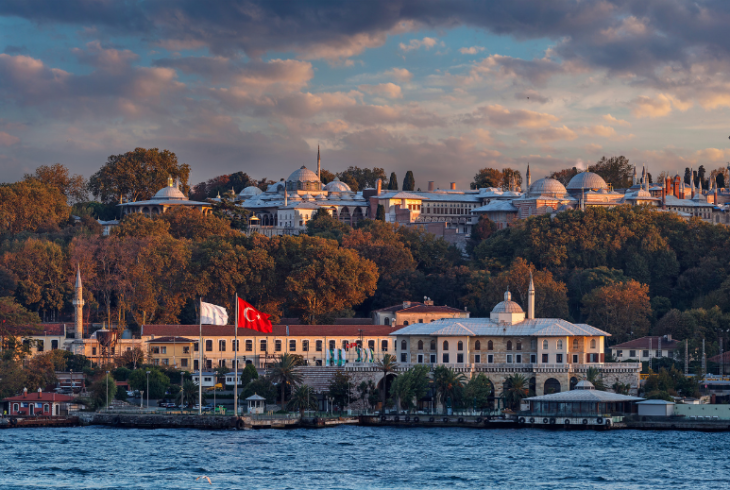The treasures of the Ottoman Sultans: What to see inside Topkapi Palace!
The history of Topkapi Palace
Visiting Topkapi Palace is like stepping back in time into the age of the Ottoman Sultans, their court, their concubines, their Harem and the eunuchs who protected them. It is a world of beauty filled with colorful gardens, spacious courtyards, elegant pavilions, fountains, baths, and exquisite views of the Bosphorus and Marmara Sea.
This incredible 15th century complex which goes back to the age of Sultan Mehmed II (Mehmed the Conqueror), was also the center of education for the Sultan’s family and members of the Imperial court and a center for the study of Ottoman art. It is a magical place which was the epicenter of power for the Ottoman Empire from the 15th to the 19th century. Since 1924 and the time of Ataturk, the palace has been opened to the public as a museum.

The courtyards of Topkapi Palace
In visiting the palace you enter through a series of gates which lead you to a series of courtyards.
The first gate is the Imperial Gate which leads you into the first courtyard known as both the parade courtyard and courtyard of the Janissaries, (Janissaries were the elite infantry used to guard the Sultan’s palace). You can imagine this courtyard filled with well dressed dignitaries passing on their way to meet with the Sultan, Ottoman nobles there on business, and of course the Janissaries in their impressive costumes lining the path as you approach the second gate. As you pass from courtyard to courtyard (if you were allowed access in the days of the Sultans) you would come closer and closer to the Sultan's actual inner world.
The gate leading to the second courtyard is the Gate of Salutations. Only the Sultan and his mother were allowed to enter this gate on horseback. The second courtyard is also known as the Council Square. Here you discover the parts of the palace which kept it functioning including the Dome Chamber, built by Suleyman the Magnificent, where meetings of the council took place. Next to the Dome Chamber is the impressive Tower of Justice. In this courtyard you find structures for both internal palace function such as barracks, and kitchens, to council chambers and the outer treasury for governmental functions.
The Gate of Salutation

Through the Gate of Felicity one enters the third courtyard, the inner section of the palace where business of state took place. According to court protocol, passing this gate was only allowed with permission of the Sultan. It was the direct domain of the Sultan guarded by eunuchs and surrounded by gardens, the Audience Chamber, the Imperial Treasury, a dormitory for the Expeditionary Force, Hall of the Privy Chamber, Library of Ahmed III, Mosque of the Agas, Dormitory of the royal pages, and the Harem. Today, this courtyard houses innumerable treasures of the Sultans. Among these treasures kept in the Sacred Safekeeping Rooms, are also some of Islam’s most important relics including relics of the Prophet kept in gold reliquaries encrusted in precious stones.
The Courtyard of the Concubines 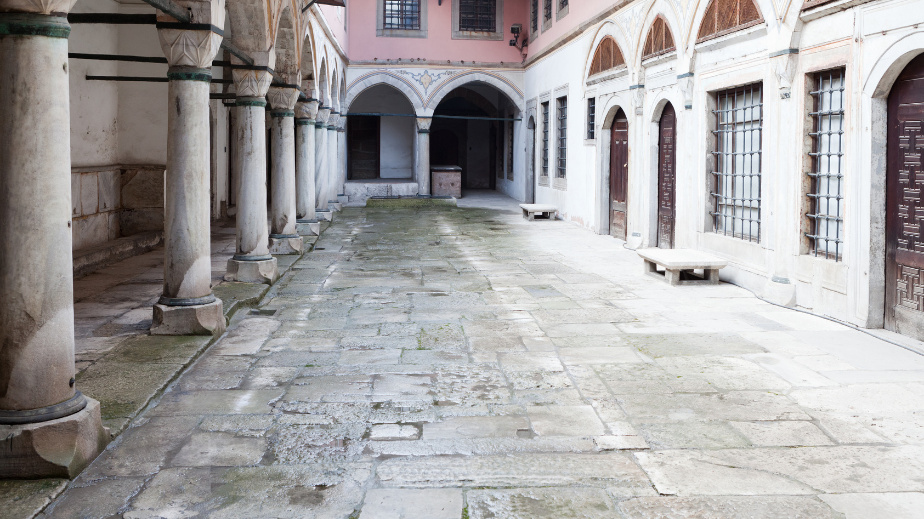
One of the most beautiful and secluded parts of the palace is the fourth courtyard. This courtyard was the most private area containing gorgeously decorated pavilions used for private family functions such as the Circumcision Room, used during the circumcision of young princes. The Baghdad Kiosk, decorated in 16th century colorful tiles and mother-of-pearl and tortoise-shell, the famous Tulip Garden, the Revan Kiosk, and also the Head Physician’s Pavillion.
The Baghdad Kiosk
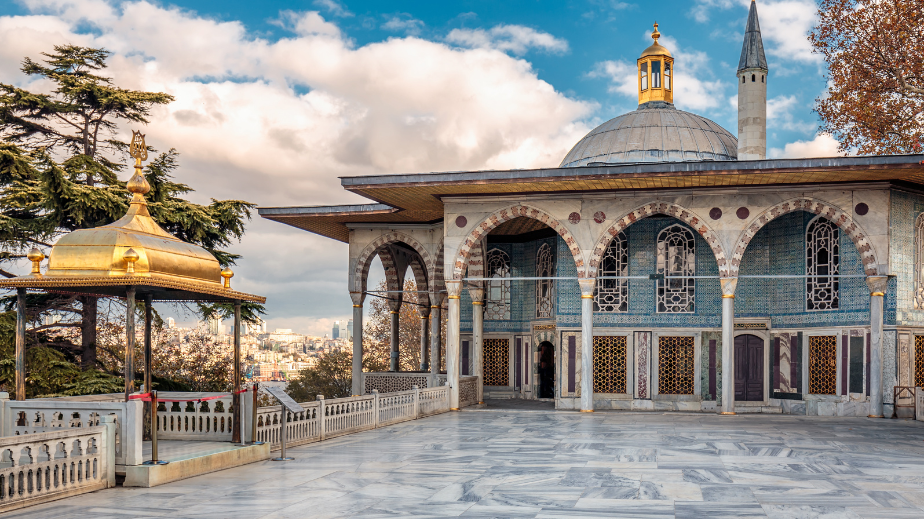
The Palace Kitchens
Kitchen Chimneys
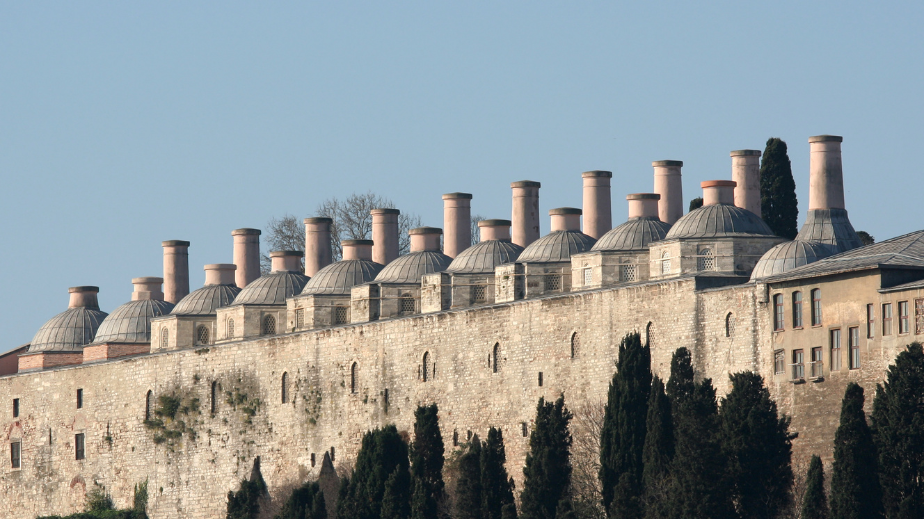
The impressive palace kitchens with their 20 chimneys just can’t be missed. Here in the working days of the palace, food was prepared daily for the over 5000 residents of the palace by a kitchen staff of approximately 800 people. Inside the kitchens was a dedicated confectionery kitchen. Today you can visit and see its collection of massive cookware, ceramics, glass and admire the Sultan’s collection of celadon porcelain. The Chinese celadon porcelain collection is the second most important in the world. It was admired by the Sultans for its reputation to change color if it came into contact by poison!
The Imperial Treasury
Palace Fountain Detail

Inside a building which was used as the reception rooms of Mehmet the Conqueror, today you can find the Imperial Treasury. Jewels, Koran covers decorated in precious jems, thrones and an extensive armory collection are just some of the items housed in the treasury. The rich collections includes, the famous Sword fo Süleyman the Magnificent, with its handle encrusted in jewels and the Topkapi Dagger decorated with emeralds. When admiring the famous Throne of Ahmed I and its beautiful mother of pearl inlay or the 86 carat spoon-makers diamond, one can only begin to imagine the wealth of the Sultans during the height of their reign.
The Harem
Harem Detail
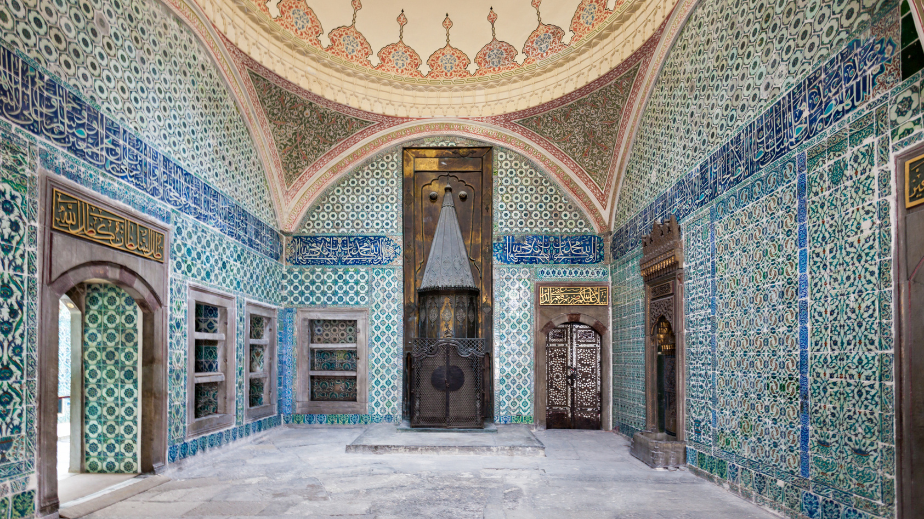
The innermost sanctuary for the Sultan and his family was the Harem. The Harem, was the forbidden section of the palace for all except the Sultan, the Sultan’s mother (Valide sultan) in her private apartments, consorts, favorites, concubines, unmarried daughters, young princes, and the Eunuchs who guarded them. The space is made of of pavilions, roads, private corridors for the Sultan, baths, mosques, gardens and more. The Harem is where the family lived, was schooled and celebrated together, all in a unique hierarchy and and with strict protocol. Over 300 rooms make up this portion of the palace and is to be visited with a separate ticket but well worth the visit!
Topkapi Palace is a shining gem of Ottoman culture and a must see site while traveling in Istanbul. Whether you are a lover of art, architecture, history or natural beauty, this palace and its gracious courtyards have something for all tastes.

